The Google Nexus 9 Review
by Joshua Ho & Ryan Smith on February 4, 2015 8:00 AM EST- Posted in
- Tablets
- HTC
- Project Denver
- Android
- Mobile
- NVIDIA
- Nexus 9
- Lollipop
- Android 5.0
Software
With the Nexus 9, Google has released the biggest upgrade to Android since 4.0. In some ways, Android 5.0 represents one of the biggest shifts in the design of the OS ever. While we’ve had JIT compiling on Dalvik since Android 2.2, this has remained largely static for the past few years during Android’s monumental growth. With Android 5.0, we see the introduction of Android Runtime, or ART. Instead of trying to compile the application right before execution, ART does most of the compilation well before the application is launched. This incurs higher storage requirements, longer app-install times, and longer first-boot times, but with great benefits to performance. Google has done a great deal of work in general to try and resolve performance issues, as we first detailed in our coverage on ART.
While performance is one major aspect of Android 5.0, Google has also fundamentally redesigned the interface. To replace Holo, Google has introduced Material Design, which emphasizes depth, physics, animation, and a new palette of colors. While it would be great to go over all of these aspects of the Nexus 9, it’s best to refer to Brandon's review of Android 5.0 Lollipop for these issues. Instead, for this review I will mostly focus on the Lollipop experience specific to the Nexus 9. This means that the focus will be on performance of the device in general usage, along with the app ecosystem for Android tablets.
Unfortunately, these seem to be sore points of the Nexus 9 and the broader Android tablet ecosystem. Without question, if we’re talking about tablet applications they definitely do exist for the Nexus 9. The problem is that there is a pervasive lack of applications that are truly designed for a 9 inch, 4:3 aspect ratio display. Applications like Twitter, Facebook, and other first-party apps are simply blown up versions of the phone application. There is some level of extra content presented, but a lot of applications just don’t scale correctly which wastes a lot of real estate on the display. While we found issue with the Nexus 6’s lack of phablet-specific layouts, this is an even bigger issue on the Nexus 9.
While it’s possible to point fingers at app developers for not supporting Android properly, Google seems to have these problems as well. The settings interface is a single large pane of options, instead of a dual-pane interface that allows for simultaneous navigation of the overall settings and individual settings. The Play Store application is mostly similar in this respect, and the YouTube app is possibly the worst example of these kinds of issues. For example, while there is a tablet-specific video view in landscape, most navigation, search, and video selection is identical to what we see on a smartphone.
Nothing really takes advantage of the screen size other than simply being bigger than before. There aren’t any multi-window modes that exploit the larger screen size, and in general the Nexus 9 doesn’t introduce any new functionality that clearly justifies the need for a bag/backpack to carry it. There are applications that take advantage of the larger display, but these are rare. For the most part though, this is effectively true for most tablets other than the Surface Pro 3 which is effectively in a different category altogether.
On the performance side, the story is better but it isn’t perfect either. Similar to Brandon’s experience with the Nexus 6, I often saw random stutters on animations such as the app drawer or while opening an application. It’s hard to say what the cause is at this point, as the Nexus 6 seems to have similar issues with lag even though the Nexus 5 has none of these issues. One might point to FDE causing worse performance, but even that isn’t quite accurate as a build of Lollipop with FDE disabled didn’t do all that much in the way of solving these problems. Overall though, the experience is somehow less performant than the SHIELD Tablet on Android 5.0, even if these issues mostly present themselves in the form of minor frame drops from time to time. I also noticed that there was a distinct lack of available memory over time, which suggests a memory leak as on reboot launcher redraws effectively disappeared.
While these are significant issues that need to be resolved, the experience isn’t actually as bad as it seems. For what it’s worth, Material Design is a great new design scheme to replace the somewhat dated Holo UI that has been in use since Honeycomb/Android 3.0. While there are issues with the tablet experience, if one is willing to look past these issues they will find that the Nexus 9 is a respectable software experience. There’s also the potential for the Nexus 9 to spur improved tablet experiences, although this would be a slow change that could take years to be meaningful.


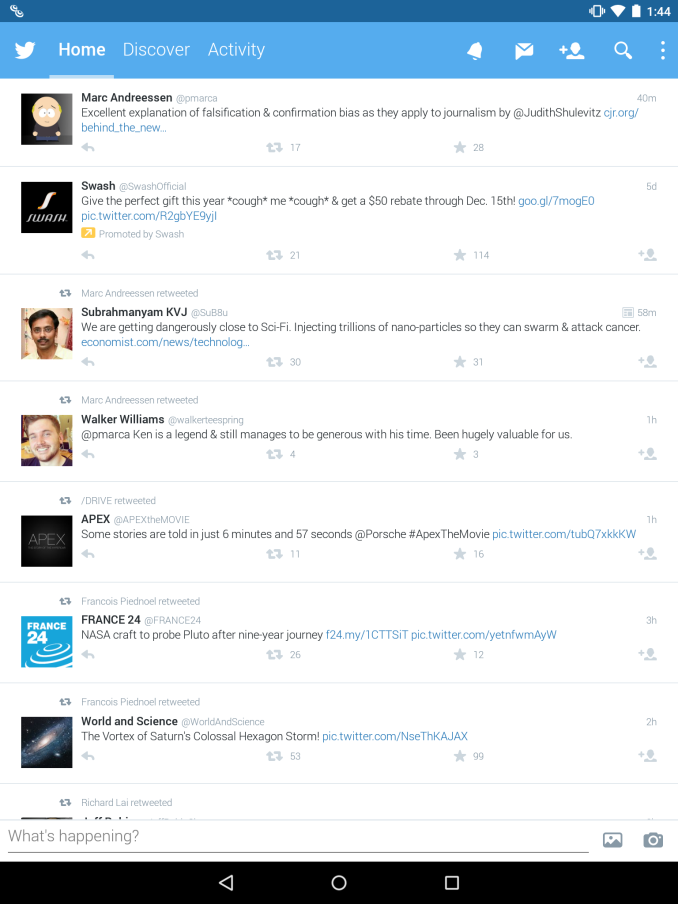
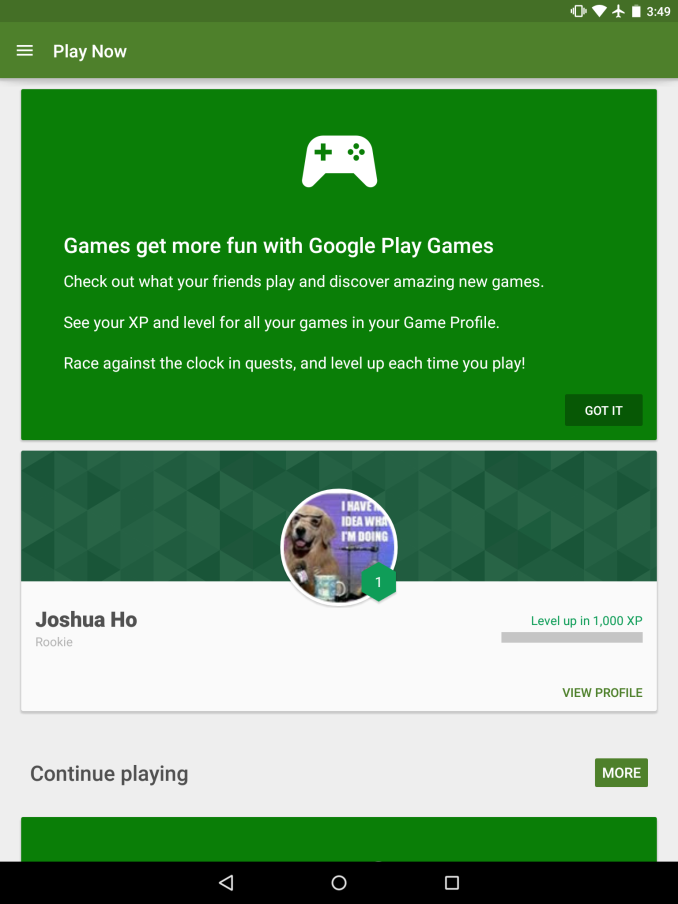
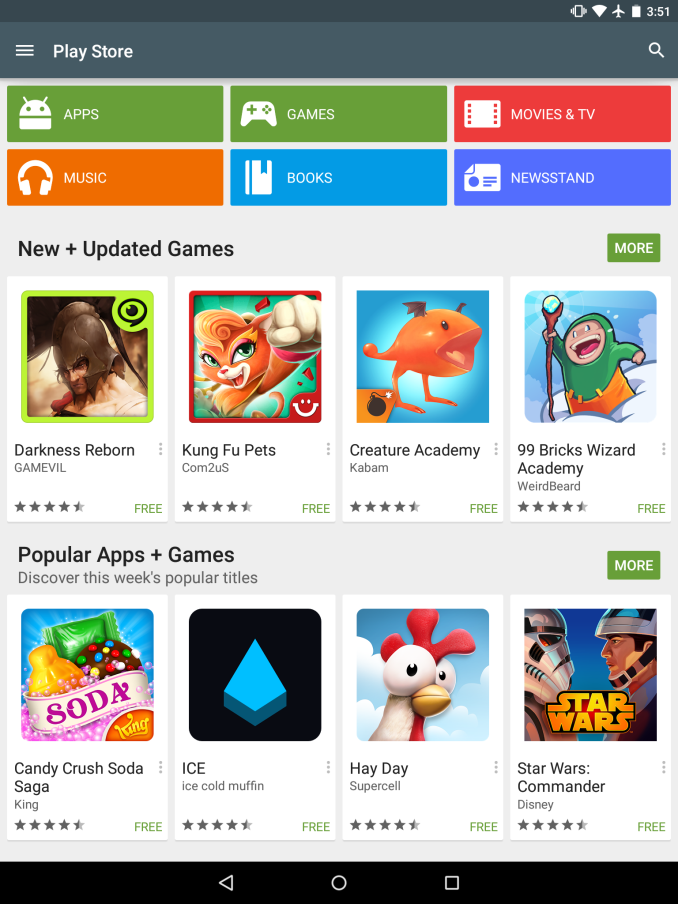
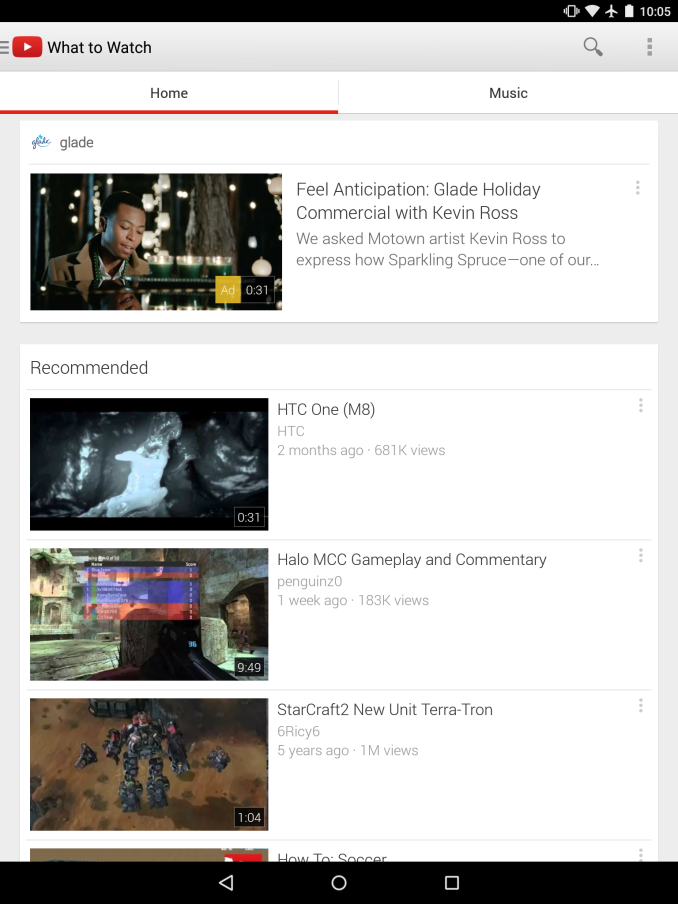
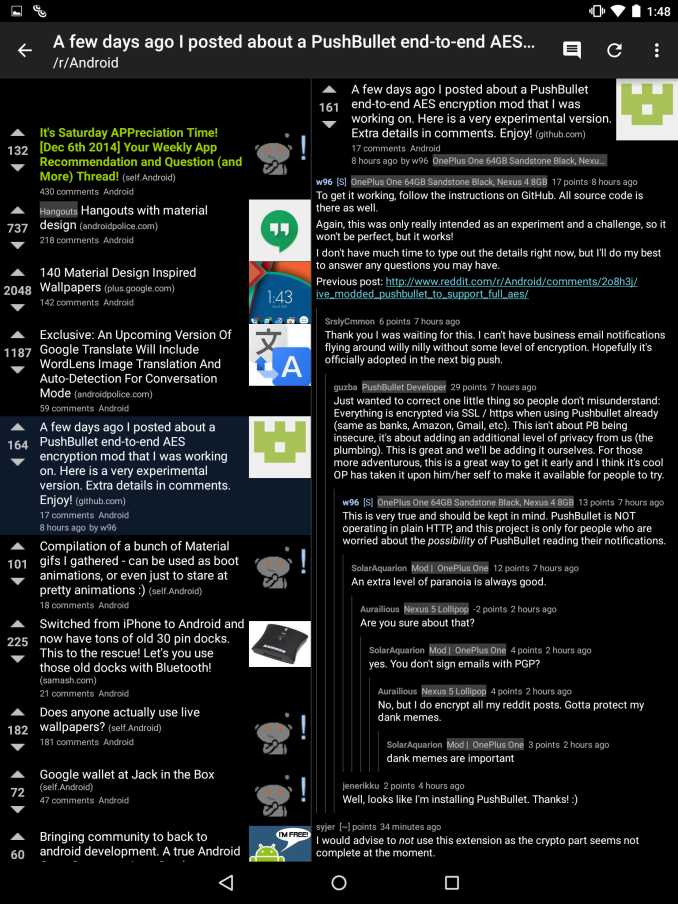








169 Comments
View All Comments
techcrazy - Friday, February 6, 2015 - link
Best Nexus 9 review i read. Excellent work anandtech team.RobilarOCN - Friday, February 6, 2015 - link
How does the Tab S fall short of the Nexus 9? I've owned both. Video playback battery life overwhelmingly supports the Tab S, it has a far superior screen (AMOLED...), It has a micro SD slot, it has the ability to connect to HDMI via MHL adapter. The only way the Nexus 9 can output video as it has no available adapter and no onboard MHL support is via 3rd party such as the Chromecast. The 16GB Nexus 9 and 16GB Tab S 8.4 are in the same price range but of course you can expand the memory on the Tab S via a micro SD card. The 32GB Nexus 9 sits in the same price range as the Tab S 10.1 and again the 10.1 can have cheap memory added to it.The only places the Nexus 9 wins is if you want a 4:3 format (and in that case the first gen IPad Air 64GB is cheaper and a better device) or if you absolutely have to have Lollipop which will eventually get to the Tab S.
UtilityMax - Sunday, February 8, 2015 - link
In my opinion Tab S will be eventually remembered as a flop. Yes, it has a great wide screen and good battery life for video playback. So it's great for watching videos, which is why I bought one (and would buy it again). Unfortunately, videos is the only thing that Tab S does truly well. The Tab S forums on the web are filled with discussions about "lag" and why Chrome can be so slow. For a flagship tablet, the CPU/GPU performance scores could have been a little better, and the standby as well as web browsing battery life could be A LOT better. The other day I was stuck in a library for hours with this tablet and came to realization that I am not sure if this thing can last for 5 hours of web browsing on a full battery charge, which is horrendous. I have a Samsung laptop with a quad core i7 CPU and 17 inch screen that could work longer on a battery charge.Basically, this tablet gives you a great screen, SD card slot, good build quality, and not much else. I am still glad I got a 10.5 Tab S on a sale for $400. However, I don't think it's really worth the "regular" price of +500 dollars.
Impulses - Monday, February 9, 2015 - link
5 hours? Yikes... My Atom netbook from half a decade ago could manage that...UtilityMax - Sunday, February 15, 2015 - link
But amazingly, the Tab S 10.5 can play a 720p video for something like 10 hours on a full charge. Go figure.mkozakewich - Friday, February 6, 2015 - link
Those NVidia charts obviously show the IPC measured in a 'ratio'. They're not going to tell us what exact IPC they get.So yeah, the highest it goes is less than 2.0, which means their IPC for optimized code isn't quite double the performance of regular ARM stuff. I'd suppose the regular code could get up to 3 IPC, which means the optimized stuff could get up to 6 IPC (out of the maximum 7). It seems to check out.
I'd have expected you not to throw caution to the wind when reading first-party benchmark slides.
flamingspartan3 - Friday, February 6, 2015 - link
The Nexus 7 2013 is still competitive in many of these benchmarks. It's remarkable how great the device is even after almost two years.UtilityMax - Sunday, February 8, 2015 - link
The criticism that there aren't enough apps for the big screen is somewhat misplaced. I suspect that web browsing, videos, ebooks, and productivity apps are the prime applications for the large screen tablets. Why bother with the facebook app, when you can just login into facebook from chrome, and with the biggish screen have access to the full facebook web site?Impulses - Monday, February 9, 2015 - link
Chrome alone probably accounts for like 80% of my tablet use (and I've had an Android tablet since the OG TF) seems that's not necessarily the norm tho...Jumangi - Monday, February 9, 2015 - link
Then why pay for a device with such high end components like the K1 SoC if your just gonna use the browser? Maybe this is what some do because the android marketplace is so limited for large tablet apps but doesn't mean its ok.